Jito introduces the Block Assembly Marketplace (BAM) to address Solana's MEV challenges, aiming to enhance transparency and efficiency in transaction processing.
In the early days of Solana, Jito effectively systematized the once-inefficient MEV extraction process through its relayer, block engine, and tip distribution program. This initiative distributed profits to stakers and enhanced network stability. However, Jito faced limitations in its architecture, including geographic concentration and limited flexibility in sequencing logic customization. BAM addresses these issues by utilizing TEE and a plugin system to enhance decentralization and flexibility.
BAM minimizes harmful MEV by safeguarding transactions before execution and allowing for customizable sequencing, enabling new DeFi protocol implementations. By pursuing long-term ecosystem growth over short-term monopolistic profits, Jito demonstrates the potential to evolve Solana into more fair and efficient blockchain.
Since 2024, the Solana ecosystem has found itself in a paradoxical situation. While the memecoin frenzy drove explosive transaction volume growth, once again proving its performance and stability, the emergence of innovative DeFi protocols remained relatively stagnant. Notably, complex financial products such as CLOB based exchanges and sophisticated PerpDEXs have been predominantly developed in the EVM ecosystem, such as Avantis on Base, Lighter on its own EVM rollup, and GTE on MegaETH, etc.
The root cause lies in Solana's structural characteristics. While Solana theoretically boasts impressive performance capable of processing tens of thousands of transactions per second (theoretically), its transaction processing architecture makes it difficult to precisely control transaction sequencing. This has led to indiscriminate attacks by MEV bots competing for favorable positions and consequently high transaction failure rates for regular users. While Jito's emergence in 2022 and its subsequent monopolistic position in Solana's MEV ecosystem brought initial stability, Jito's structure still had limitations: restricted app-level transaction sequencing control and opacity in the MEV extraction process.
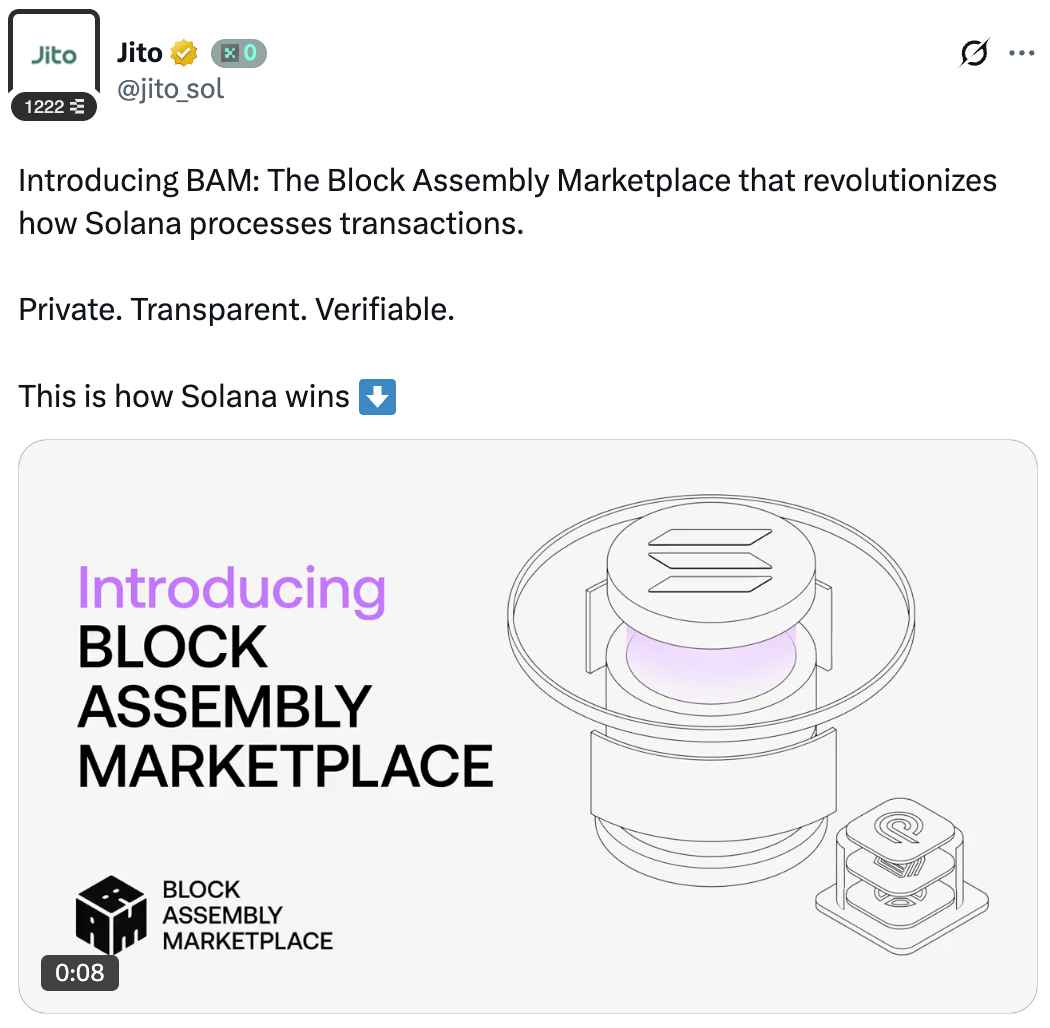
Source: Jito
Against this backdrop, Jito announced the Block Assembly Marketplace (BAM), presenting a new turning point for the Solana ecosystem. Jito emphasized that BAM would bring verifiability, transparency, and privacy to Solana's MEV ecosystem, highlighting its potential to evolve Solana from a mere high-speed network to transparent and fair financial infrastructure.
In this article, we'll explore how Solana's MEV ecosystem has evolved with Jito at its center, analyze its current limitations, examine how BAM aims to improve the current MEV ecosystem, and discuss the positive outcomes BAM could bring to the Solana ecosystem.
In the early days of Solana, its MEV ecosystem was truly a dark forest. This stems from Solana's fundamentally different approach to transaction processing compared to Ethereum. The most significant difference affecting Solana's MEV ecosystem is the absence of a global mempool. While all nodes on Ethereum can see pending transactions, on Solana, transactions are sent directly to current or future 'Leader' validators. Each validator has exclusive rights to produce blocks for approximately 400ms according to a predetermined schedule, which is called a 'leader slot.' While this structure enables Solana to process tens of thousands of transactions per second, it creates a unique environment for MEV extraction. Leaders have immense power to determine transaction order, while other participants cannot predict which transactions will be processed, causing MEV bots to employ increasingly aggressive strategies.
Due to the absence of a global mempool, MEV searchers resorted to highly inefficient methods, either dealing directly with validators or extracting MEV through spam transactions. While Solana's speed and high throughput created numerous MEV opportunities compared to other networks, situations with massive user transaction influxes (like popular NFT collection mints or IDOs) led to excessive MEV extraction attempts that degraded network usability and sometimes even caused network halts.
2.2.1 Jito's Initial Strategy
Jito emerged in early 2022 when Solana's MEV issues reached their peak. Solana was facing heavy criticism for network outages, and the success rate of regular users' transactions had plummeted due to indiscriminate spam from MEV bots. As the network essentially became almost paralyzed during popular NFT mints or IDO, the Solana community recognized the urgent need for an own MEV infrastructure.
Jito was born to solve precisely these problems, with a vision of systematization and democratization of MEV. The goal was to transform chaotic MEV extraction into an orderly system, improving network stability and distributing MEV profits to regular stakers.
Jito's initial strategy was clear: solve Solana's structural limitation of lacking a global mempool through off-chain solutions, and encourage MEV bots to compete orderly through an auction system instead of blindly sending spam. To achieve this, Jito began partnering with validators in the second half of 2022 while providing MEV searchers with more efficient extraction methods.
2.2.2 Jito's Core Architecture
Jito efficiently captures and distributes MEV through the organic connection of three components, each performing the following roles:
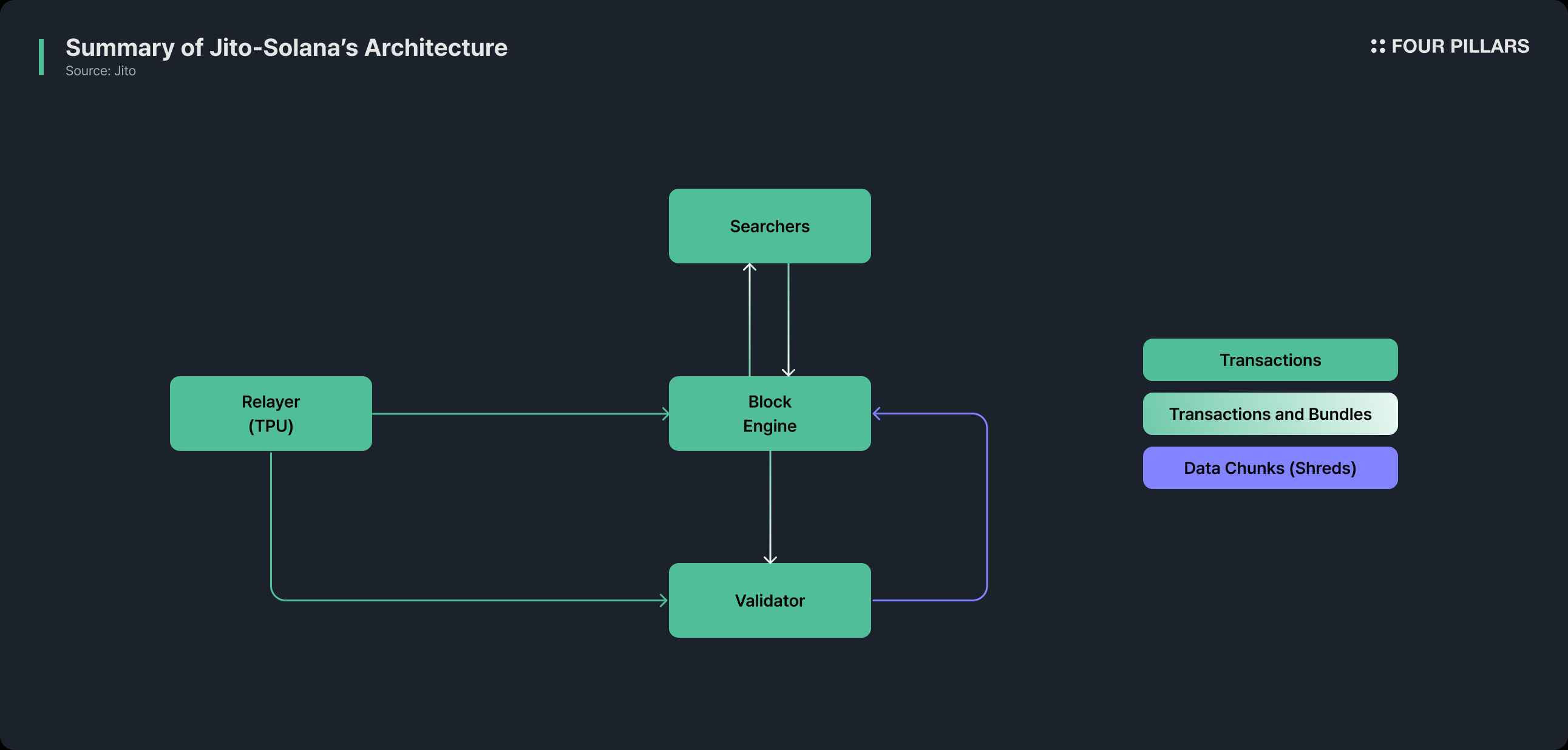
Relayer: Acts as the gateway for transactions. All transactions through Jito first pass through the relayer, with a 200ms intentional delay. During this brief period, MEV searchers can analyze incoming transactions, identify MEV extraction opportunities like arbitrage or liquidations, and bundle their own transactions. The relayer also reduces validator burden by filtering out meaningless transactions through spam filtering. This significantly improves network stability by preemptively blocking the numerous spam transactions that validators previously had to process directly.
Block Engine: The most critical component of Jito, implementing a sealed-bid auction mechanism similar to Ethereum's Flashbots, adapted for Solana's environment. The block engine operates a virtual mempool off-chain and simulates bundles submitted by searchers in real-time. Each bundle is evaluated based on execution results and offered tips, with the most profitable bundles selected. Crucially, this process must complete within Solana's 400ms leader slot. The block engine also runs complex algorithms to detect conflicts between bundles and find optimal combinations.
Tip Distribution Program: Beyond improving transaction processing mechanisms, Jito implemented a system to distribute MEV revenue opportunities to regular users, ensuring everyone can benefit from MEV opportunities. Jito introduced an auction mechanism where users can bid "tips" for additional transaction inclusion guarantees, while MEV searchers pay tips as fees to include their bundles in blocks. These tips accumulate in Jito's smart contracts and are periodically distributed. Jito receives SOL deposits from users and issues JitoSOL, a liquid staking token. JitoSOL holders receive Jito's accumulated tips as yield, naturally gaining exposure to MEV revenue.
This structure enables numerous searchers to extract MEV within Solana's fast block time without compromising network performance. As of 2025, thousands of bundles are processed through Jito every second.
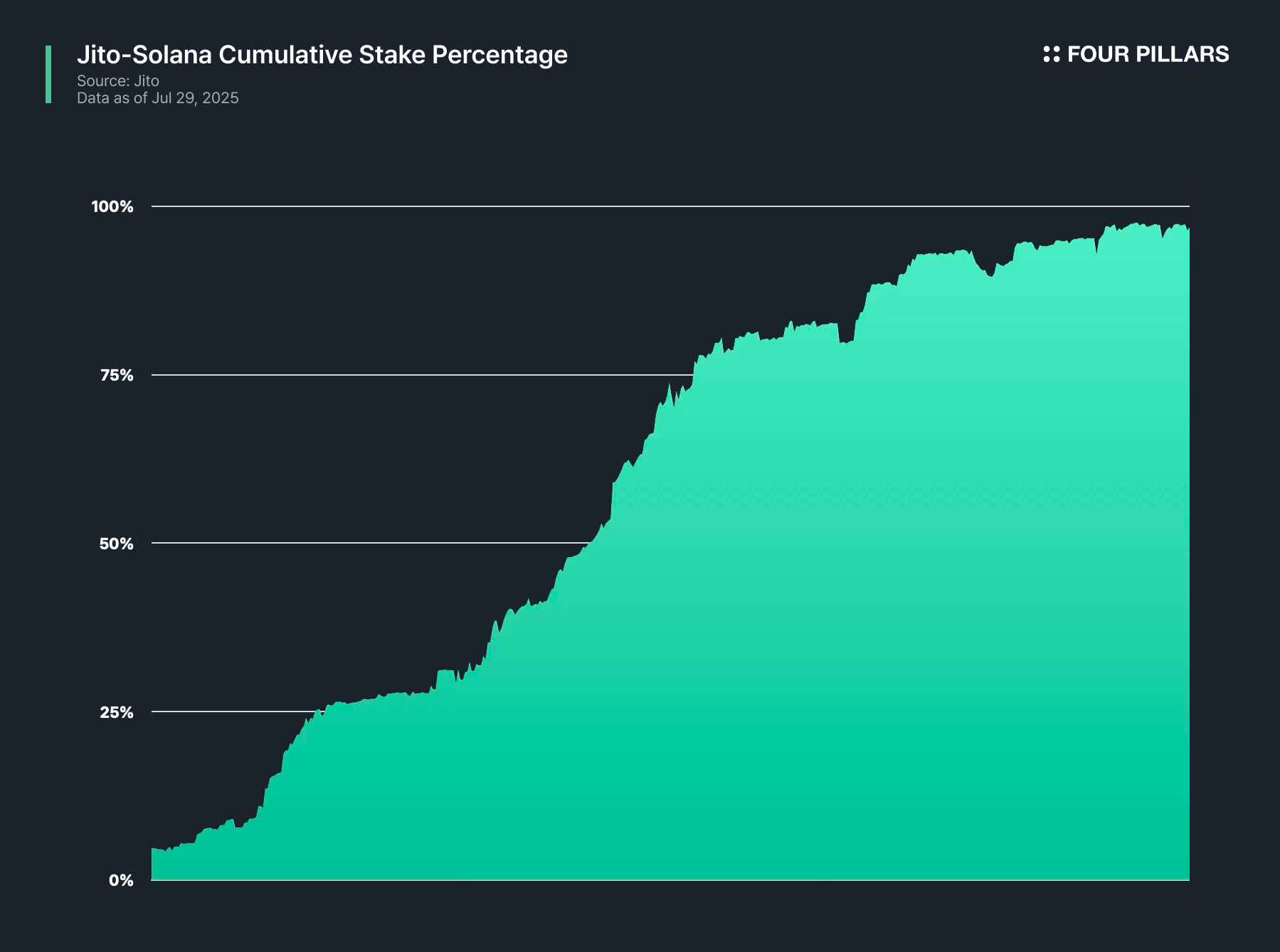
Source: Jito
Jito has successfully established itself as core infrastructure for Solana, securing ~97% of the network's total stake. Approximately $2.5 billion in annual MEV fees are distributed to validators and stakers through Jito, becoming a key economic driver for the Solana ecosystem.
Despite these achievements, Jito has continuously faced criticism for several structural shortcomings. The most prominent issue is the centralization of the block engine. Since Jito's block engine is essentially a centralized off-chain system where all MEV bundle auctions occur on Jito-operated server clusters, this creates several problems:
Limited Flexibility: Jito's system makes it difficult to customize sequencing logic. In the existing system, developers cannot control transaction order at the application level, limiting the implementation of complex financial primitives like CLOBs or PerpDEXs.
Single Point of Failure in the Block Engine: Jito's block engine effectively acts as the monopolistic gatekeeper for Solana's MEV infrastructure. The Jito block engine outage in November 2024 clearly demonstrated the dangers of such centralization. When Jito's block engine stopped working for about an hour, MEV extraction on Solana was effectively paralyzed. Arbitrage traders and sniping bots resorted to raising Solana's base fees instead of paying tips to Jito to succeed in their transactions. This caused Solana's fees to spike 25-30x, and some applications with fee limits essentially ceased functioning, causing user inconvenience. This highlighted the need to decentralize Solana's MEV ecosystem structure concentrated in Jito.
Geographic Centralization and Latency Games: Jito's block engine currently operates in only 7 regions: Amsterdam, Frankfurt, London, Singapore, New York, Salt Lake City, and Tokyo. This may lead to potential regional centralization where MEV activity concentrates in specific regions like Amsterdam, providing relative advantages to searchers physically located nearby. Jito specifies that optimal round-trip latency between block engines and validators should be under 50ms, structurally advantaging participants in certain locations.
Despite the positive changes Jito brought to Solana's MEV ecosystem, these issues highlight the need for more decentralized, transparent, and censorship-resistant solutions. From a long-term perspective, we cannot continue relying on the goodwill of a few centralized actors to maintain network decentralization; we need a robust economic system that makes decentralization the most efficient outcome.
In the existing Jito block engine, there was no way to externally verify how off-chain auctions were conducted or whether bundle selection algorithms were truly fair. Users simply had to trust Jito. BAM addresses this issue by introducing Trusted Execution Environments (TEE).
TEE is a hardware security module that performs computations in a secure environment, which guarantees the integrity code and data stored inside encrypted memory (enclave), through the cryptographic verification supported by hardware vendors. BAM prevents validators from performing sequencing through arbitrary logic by having each node perform transaction sequencing inside TEE enclave. Additionally, transactions remain encrypted until execution, and TEE’s remote attestation allows verification that sequencing has been performed by the exact predefined logic with no arbitrary intervention.
In the existing Jito block engine, all transactions adhered to a uniform sequencing logic. Bundles submitted by MEV searchers were prioritized solely based on the size of offered tips, leaving developers unable to reflect their application-specific sequencing needs. This limitation was particularly restrictive for protocols attempting to implement complex financial primitives.
For instance, CLOB requires order time priority, while perpetual futures exchanges need protection mechanisms to prevent market manipulation. Unfortunately, the existing system did not allow for such specific implementation of sequencing logics.
BAM enables developers, traders, and applications to implement plugin software that connects to the scheduler responsible for transaction sequencing in BAM nodes, allowing interaction with Solana transactions. This provides flexibility for each application to implement its own unique transaction processing rules, departing from the rigid structure of the existing Jito block engine.
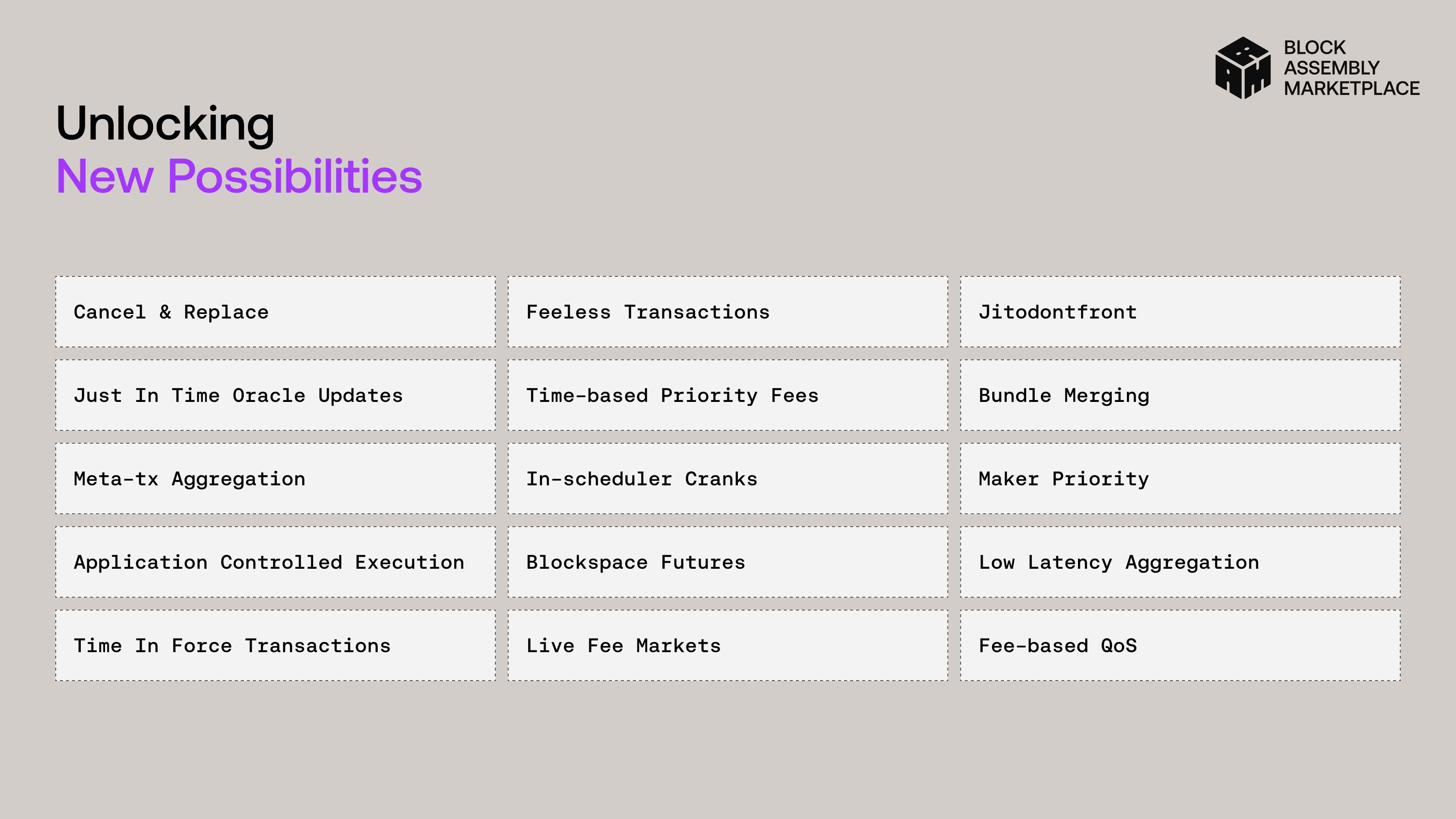
Source: Block Assembly Marketplace
This plugin system enables the implementation of various mechanisms that were previously difficult in the Solana ecosystem due to Solana's fast block time and immediate execution model.
BAM presents Just-In-Time (JIT) oracles as an example of what plugins can implement. Oracle providers like Pyth maintain over 1,600 price feeds, which previously required continuous updates, incurring massive transaction costs. Despite this, liquidations or arbitrage opportunities sometimes arose from outdated price information. BAM's plugins enable mechanisms to perform oracle updates only in specific blocks, contributing to a more efficient DeFi ecosystem.
Plugins for market makers are another notable example. In traditional financial markets, about one-third of orders are canceled or modified within 50ms after trading. This is essential activity for market makers to continuously rebalance positions and avoid unfavorable executions. However, from a network perspective, such repetitive actions border on spam and compete with regular user orders, causing network congestion. Through BAM's plugins, developers can implement custom sequencing rules that prioritize market maker orders, ensuring smooth trading environments for market makers while providing users with deeper liquidity and tighter spreads.
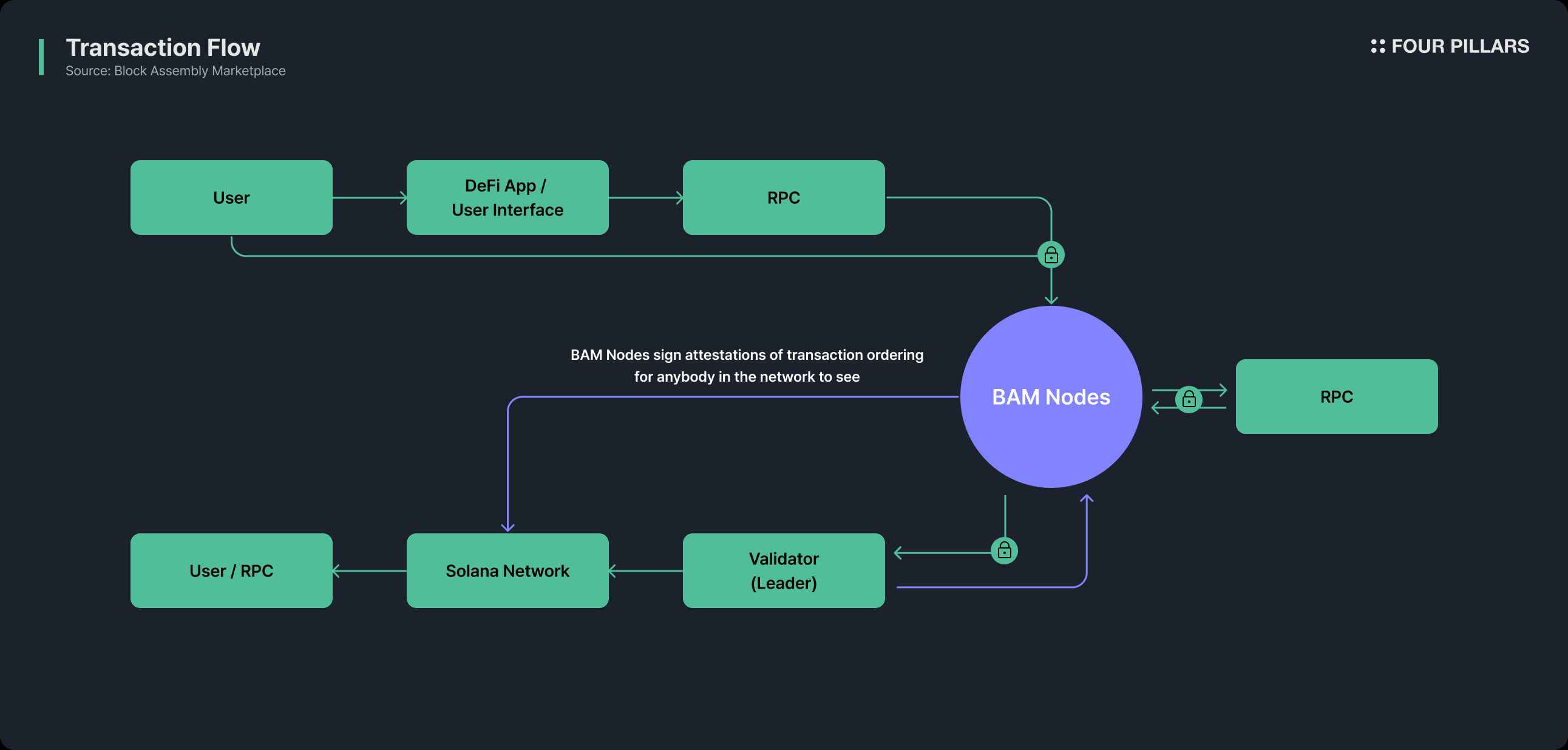
BAM's transaction processing takes a fundamentally different approach from Solana's simple first-come-first-served processing or Jito's tip-based auctions. The entire process consists of four stages, with each stage verifying the results of the previous stage and generating proofs for the next stage in a chain structure.
Transaction Submission: Users, traders, market makers, or applications send transactions to BAM nodes. Transactions are immediately transferred into the TEE and encrypted, meaning transaction contexts are protected immediately upon submission, unlike existing systems where anyone can see transaction contents as they propagate through the network.
Sequencing and Attestation: BAM nodes receive, filter, and sort transactions in the TEE's encrypted region called the Enclave, during which plugins can operate to insert additional transactions. For example, if a DeFi protocol submits a transaction to process loan liquidations, an oracle plugin can automatically include the latest price information in the same block to ensure liquidations occur at accurate prices. Once all sequencing is complete, the BAM node sends transactions to the leader and simultaneously generates and stores cryptographic attestation of sequencing.
Execution: The current leader validator executes transactions received from the BAM node as instructed. Crucially, the leader cannot arbitrarily change transaction order at this point. Any attempt to change would not match the sequencing proof stored by the BAM node and would be immediately detected by the network. Upon completion, the leader provides proof of correct execution to the BAM node.
Public Audit Trail: All proofs generated by BAM nodes and validators are permanently recorded on-chain and accessible to anyone. This allows verification even after the fact of how transactions were processed in specific blocks and whether leaders followed instructions properly.
How will BAM's structure affect performance compared to the existing Jito block engine? While no public benchmarks exist yet, the computational overhead within TEE is not expected to be significantly slower than existing block engine-based sequencing mechanisms. Since block generation must still occur within Solana's leader slots, there should be no difference in user experience.
According to data from Blockworks Research, Jito generated approximately $25 million in revenue in Q4 2024 from block engine fee commissions alone. Moreover, Jito has secured over 97% of Solana's total stake, effectively monopolizing Solana's MEV infrastructure. Given this situation, why would Jito introduce BAM, which could threaten its monopolistic position and revenue?
While it may seem irrational on the surface, this represents Jito's strategic decision to choose long-term sustainability over short-term profits. As mentioned earlier, Solana's MEV environment's complete dependence on Jito carries various risks, and profit distribution through decentralization can paradoxically ensure Jito's long-term survival. Additionally, rather than having development speed depend on Jito Labs through monopolization, opening the ecosystem allows developers to experiment with and implement new mechanisms, ultimately reviving the entire Solana ecosystem, driving more transactions, and leading to Jito's success. Jito plans to actively pursue decentralization by gradually opening BAM node operations, open-sourcing the code, and transferring governance to the community.
Jito also aims to overcome the geographic limitations of the existing Jito block engine system through geographic distribution of BAM nodes, contributing to overall Solana network stability. BAM plans to have over 50 geographically distributed nodes operated by third-party operators, overcoming the limitations of block engines currently concentrated in Amsterdam, Frankfurt, New York, and Tokyo. This ensures MEV infrastructure safety even under national regulatory circumstances and distributes the competitive environment, unlike the previous situation where searchers competed by placing computing environments physically close to block engine operating regions, allowing users worldwide to have equal competitive opportunities.
BAM doesn't simply abandon existing revenue but creates larger, more sustainable revenue models. The Jito Foundation and Jito Labs are preparing a proposal to send all fees collected from BAM and the Jito block engine to the DAO Treasury.
The core of the new revenue model is the plugin economy. A portion of fees charged by apps for plugin features will be shared with validators and the Jito DAO, creating a structure where the entire ecosystem grows together. For example, if a successful DEX generates $1M monthly revenue through plugins, portions would be distributed to BAM node operators, validators, and the Jito DAO. All participants contribute to ecosystem growth and share in the results. Additionally, protocols generating revenue through plugins will have incentives to share profits with their token holders, leading to value redistribution in the Solana DeFi ecosystem and potentially creating a larger pie.
BAM mitigates harmful MEV strategies like sandwich attacks by encrypting transactions until execution through TEE. However, importantly, BAM doesn't attempt to completely eliminate MEV. This is because some forms of MEV, like arbitrage and liquidations, positively contribute to market efficiency.
BAM's approach is to "tame" MEV. While technically blocking harmful forms of MEV, it helps beneficial forms operate more efficiently. For example, arbitrage bots that resolve price differences between DEXs can still operate, but sandwiching regular users' trades becomes impossible (excluding blind MEV performed purely through prediction without observing user transaction contents). This approach enhances overall ecosystem health while maintaining necessary market functions.
BAM also brings important improvements at the network level. Currently, Solana periodically experiences congestion due to spam transactions from MEV bots, and user experience severely degrades during popular events. BAM's plugin system allows each application to have its own transaction processing rules, fundamentally blocking meaningless spam and effectively increasing the entire network's processing capacity.
Transaction failure rates can also significantly decrease. Currently, when the network is congested, bots monopolize block space by paying massive fees, but BAM's plugin system enables each application to secure block space for its users.
BAM enables new types of DeFi protocols that were previously difficult to implement on Solana. Most notable is the on-chain CLOB. CLOBs are core infrastructure in traditional financial markets, matching buy and sell orders according to price and time priority. However, implementing a CLOB where users can trade reliably is currently very difficult in an environment where transaction order cannot be guaranteed and MEV bots can manipulate order flow.
BAM's plugin system solves this problem. CLOB plugins can record the exact time orders were submitted and ensure orders at the same price are processed in chronological order. Furthermore, they can grant special priority for market makers or apply special processing rules for large orders.
Perpetual Futures exchanges will also experience improvements. Currently, Solana's perpetual DEXs lag behind centralized exchanges in several aspects. Major issues include uncertainty in order execution, manipulation by MEV bots, and lack of incentives for market makers. Through BAM, these DEXs can introduce advanced features like those implemented by Hyperliquid. For example, rate limiting to prevent large traders from exploiting small traders, fee discounts for market makers, and ensuring fairness in liquidation processes become possible.
BAM's plugin system closely resembles App-Specific Sequencing (ASS) that has undergone research and development in the Ethereum ecosystem in terms of functionality.
Ethereum also suffered from network congestion due to MEV, similar to Solana, despite having a global mempool, due to the immense power given to early block builders and MEV opacity. Flashbots proposed the Proposer-Builder Separation (PBS) structure to solve Ethereum's MEV problems, allowing MEV searchers to submit transaction bundles directly to block builders and include them in blocks through off-chain auctions, aiming to decentralize MEV profits. However, Flashbots initially also had issues with centralized relayers and builders' single points of failure, similar to Jito's block engine centralization problem.
To overcome these limitations, Ethereum proposed the concept of app-specific sequencing, allowing applications to determine transaction order independently. As proposed in Ethereum's rollup ecosystem or Flashbots-led project SUAVE, each app (or appchain) would operate independent sequencers to customize transaction sequencing. This ensures fair order matching in complex financial apps like CLOBs or perpetual DEXs and enables MEV optimization at the app level. Specifically, SUAVE was designed to use trusted execution environments to prevent sequencers from performing malicious MEV extraction on user transactions and allow applications to define sequencing logic through separate modules. This structure is very similar to BAM's plugin system.
BAM can be seen as the result of applying this structure to Solana's unique MEV ecosystem. While app-specific sequencing in Ethereum focuses on being performed through separate rollups, BAM provides similar functionality through plugins within Solana's single-chain structure. This represents Solana absorbing app-specific sequencing at the chain level beyond Ethereum's rollup-based model, and the different approaches between the two chains will likely lead to cross-development and convergent evolution of MEV ecosystems.
BAM's emergence represents not just a change in one protocol called Jito, but one of the major puzzle pieces in Solana's long-term vision of 'Internet Capital Markets' (ICM).
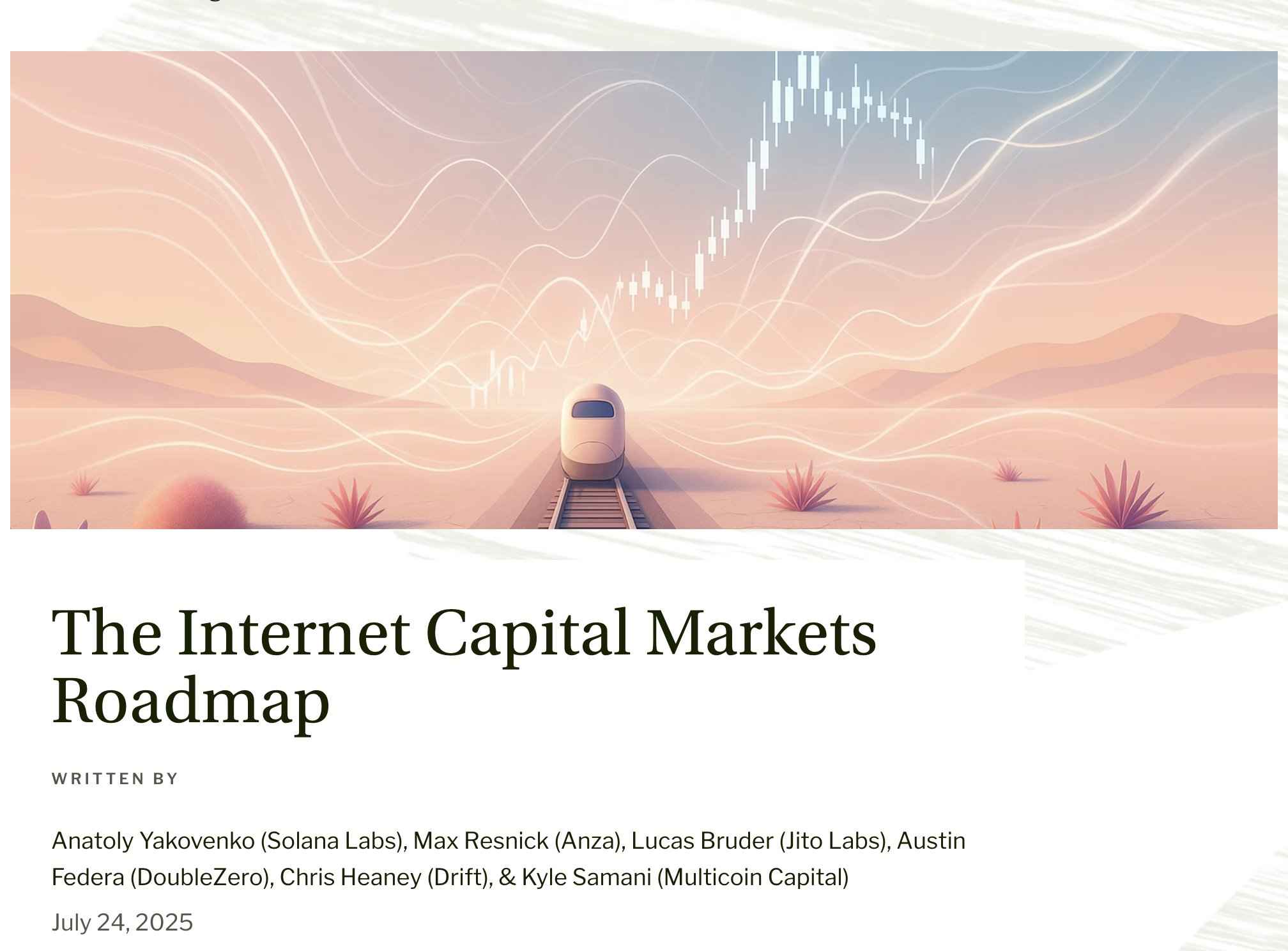
Source: Anza
In July 2025, key contributors to the Solana ecosystem published 'The Internet Capital Markets Roadmap,' presenting Solana's long-term vision. They argued that "market microstructure is the most important issue on Solana today" and that true decentralized financial infrastructure cannot be built with just fast processing speeds alone. They emphasized that achieving this requires 'Application-Controlled Execution (ACE),' where each application can control its own transaction sequencing.
BAM is the first practical implementation of this ACE. The fact that major Solana ecosystem players like Drift, Pyth, and Dflow have already begun developing BAM plugins demonstrates this is a consensus direction for the entire ecosystem.
Particularly noteworthy is that BAM provides a platform to experiment with various market structure trade-offs presented in the ICM roadmap. Through BAM's plugin system, the Solana ecosystem can experiment with preferences for different trading environments, including privacy versus transparency and maker versus taker priorities. Rather than forcing a single market structure, Solana has chosen a pragmatic approach of "running numerous experiments simultaneously to find the optimal equilibrium."
While Jito's decision to abandon its monopolistic position and open the ecosystem through BAM deserves praise at the protocol level, we must also understand this as a strategic choice at the chain level to achieve Solana's long-term vision. Awakening the sleeping Solana ecosystem is not simply about one protocol, but the first step toward a vision shared by the entire ecosystem.
Dive into 'Narratives' that will be important in the next year